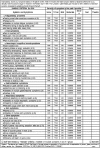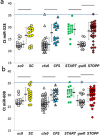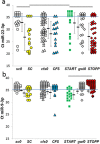Exercise - induced changes in cerebrospinal fluid miRNAs in Gulf War Illness, Chronic Fatigue Syndrome and sedentary control subjects
- PMID: 29127316
- PMCID: PMC5681566
- DOI: 10.1038/s41598-017-15383-9
Exercise - induced changes in cerebrospinal fluid miRNAs in Gulf War Illness, Chronic Fatigue Syndrome and sedentary control subjects
Erratum in
-
Author Correction: Exercise - induced changes in cerebrospinal fluid miRNAs in Gulf War Illness, Chronic Fatigue Syndrome and sedentary control subjects.Sci Rep. 2018 Apr 19;8(1):6455. doi: 10.1038/s41598-018-23238-0. Sci Rep. 2018. PMID: 29674668 Free PMC article.
Abstract
Gulf War Illness (GWI) and Chronic Fatigue Syndrome (CFS) have similar profiles of pain, fatigue, cognitive dysfunction and exertional exhaustion. Post-exertional malaise suggests exercise alters central nervous system functions. Lumbar punctures were performed in GWI, CFS and control subjects after (i) overnight rest (nonexercise) or (ii) submaximal bicycle exercise. Exercise induced postural tachycardia in one third of GWI subjects (Stress Test Activated Reversible Tachycardia, START). The remainder were Stress Test Originated Phantom Perception (STOPP) subjects. MicroRNAs (miRNA) in cerebrospinal fluid were amplified by quantitative PCR. Levels were equivalent between nonexercise GWI (n = 22), CFS (n = 43) and control (n = 22) groups. After exercise, START (n = 22) had significantly lower miR-22-3p than control (n = 15) and STOPP (n = 42), but higher miR-9-3p than STOPP. All post-exercise groups had significantly reduced miR-328 and miR-608 compared to nonexercise groups; these may be markers of exercise effects on the brain. Six miRNAs were significantly elevated and 12 diminished in post-exercise START, STOPP and control compared to nonexercise groups. CFS had 12 diminished miRNAs after exercise. Despite symptom overlap of CFS, GWI and other illnesses in their differential diagnosis, exercise-induced miRNA patterns in cerebrospinal fluid indicated distinct mechanisms for post-exertional malaise in CFS and START and STOPP phenotypes of GWI.
Conflict of interest statement
The authors declare that they have no competing interests.
Figures










Similar articles
-
Exercise modifies glutamate and other metabolic biomarkers in cerebrospinal fluid from Gulf War Illness and Myalgic encephalomyelitis / Chronic Fatigue Syndrome.PLoS One. 2021 Jan 13;16(1):e0244116. doi: 10.1371/journal.pone.0244116. eCollection 2021. PLoS One. 2021. PMID: 33440400 Free PMC article.
-
Exercise alters cerebellar and cortical activity related to working memory in phenotypes of Gulf War Illness.Brain Commun. 2020;2(1):fcz039. doi: 10.1093/braincomms/fcz039. Epub 2020 Jan 12. Brain Commun. 2020. PMID: 32025659 Free PMC article.
-
Connectivity differences between Gulf War Illness (GWI) phenotypes during a test of attention.PLoS One. 2019 Dec 31;14(12):e0226481. doi: 10.1371/journal.pone.0226481. eCollection 2019. PLoS One. 2019. PMID: 31891592 Free PMC article. Clinical Trial.
-
Review of the Midbrain Ascending Arousal Network Nuclei and Implications for Myalgic Encephalomyelitis/Chronic Fatigue Syndrome (ME/CFS), Gulf War Illness (GWI) and Postexertional Malaise (PEM).Brain Sci. 2022 Jan 19;12(2):132. doi: 10.3390/brainsci12020132. Brain Sci. 2022. PMID: 35203896 Free PMC article. Review.
-
Dysregulation of cellular energetics in Gulf War Illness.Toxicology. 2021 Sep;461:152894. doi: 10.1016/j.tox.2021.152894. Epub 2021 Aug 10. Toxicology. 2021. PMID: 34389359 Review.
Cited by
-
Role of Extracellular Vesicles in Substance Abuse and HIV-Related Neurological Pathologies.Int J Mol Sci. 2020 Sep 15;21(18):6765. doi: 10.3390/ijms21186765. Int J Mol Sci. 2020. PMID: 32942668 Free PMC article. Review.
-
Infection Elicited Autoimmunity and Myalgic Encephalomyelitis/Chronic Fatigue Syndrome: An Explanatory Model.Front Immunol. 2018 Feb 15;9:229. doi: 10.3389/fimmu.2018.00229. eCollection 2018. Front Immunol. 2018. PMID: 29497420 Free PMC article. Review.
-
A Paradigm for Post-Covid-19 Fatigue Syndrome Analogous to ME/CFS.Front Neurol. 2021 Aug 2;12:701419. doi: 10.3389/fneur.2021.701419. eCollection 2021. Front Neurol. 2021. PMID: 34408721 Free PMC article.
-
Informatics Inference of Exercise-Induced Modulation of Brain Pathways Based on Cerebrospinal Fluid Micro-RNAs in Myalgic Encephalomyelitis/Chronic Fatigue Syndrome.Netw Syst Med. 2020 Nov 18;3(1):142-158. doi: 10.1089/nsm.2019.0009. eCollection 2020. Netw Syst Med. 2020. PMID: 33274349 Free PMC article.
-
Cerebrospinal fluid metabolomics, lipidomics and serine pathway dysfunction in myalgic encephalomyelitis/chronic fatigue syndroome (ME/CFS).Sci Rep. 2025 Mar 3;15(1):7381. doi: 10.1038/s41598-025-91324-1. Sci Rep. 2025. PMID: 40025157 Free PMC article.
References
-
- Carruthers BM, et al. Myalgic Encephalomyelitis/chronic fatigue syndrome: Clinical working case definition, diagnostic and treatments protocols. J. C. F. S. 2003;11:7–115.
-
- Beyond Myalgic Encephalomyelitis/Chronic Fatigue Syndrome: Redefining an Illness. (Institute of Medicine, 2015). - PubMed
-
- Centers for Disease Control and Prevention (CDC). Unexplained illness among Persian Gulf War veterans in an Air National Guard Unit: preliminary report–August 1990-March 1995. M.M.W.R. Morb. Mortal. Wkly. Rep. 44, 443–7 (1995). - PubMed
Publication types
MeSH terms
Substances
Grants and funding
LinkOut - more resources
Full Text Sources
Other Literature Sources
Medical

